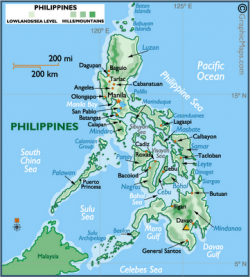The Beginning

The History of the Philippines is believed to have begun with the arrival of the first humans via land bridges at least 30,000 years ago.[1] The first recorded visit from the West is the arrival of Ferdinand Magellan on Homonhon Island, southeast of Samar on March 16, 1521.[2] Although, prior to Magellan's arrival, there was already established the Sultanate of Sulu in which the administrative center is the present day town of Jolo, the capital of Sulu. The Sultanate was recognized as a sovereign state by China which conducted trade with the sultanate and the Sultanate of Brunei whose rulers were actually cousins of the Sultan of Sulu.
Spanish colonization began with the arrival of Miguel López de Legazpi's expedition in 1565 and permanent settlement on the island of Cebu,[3] and more settlements continued northward reaching the bay of Manila on the island of Luzon in 1571.[4] In Manila, they established a new town and thus began an era of Spanish colonization that lasted for more than three centuries.[5]
Spanish rule brought political unification to an archipelago of previously independent islands and communities that later became the Philippines, and introduced elements of western civilization such as the code of law, printing and the calendar. The Philippines was ruled as a territory of the Viceroyalty of New Spain and administered from Mexico City, Mexico from 1565 to 1821, and administered directly from Madrid, Spain from 1821 until the end of the Spanish-American War in 1898, with a brief interlude from 1762 to 1764 when it was ruled by Britain. During the Spanish period numerous towns were founded, infrastructures built, new crops and livestock introduced, and trade flourished. Spanish missionaries converted most of the population to Christianity and founded schools, universities and hospitals across the islands.
The Philippine Revolution against Spain began in April 1896, culminating two years later with a proclamation of independence and the establishment of the First Philippine Republic. However, the Treaty of Paris, at the end of the Spanish-American War, transferred control of the Philippines to the United States. This agreement was not recognized by the Philippine Government which, on June 2, 1899, proclaimed a Declaration of War against the United States.[6] The Philippine-American War which ensued resulted in massive casualties.[7] Filipino leader Emilio Aguinaldo was captured in 1901 and the U.S. government declared the conflict officially over in 1902. The Filipino leaders, for the most part, accepted that the Americans had won, but hostilities continued until 1913. U.S. colonial rule of the Philippines started in 1905 with very limited local rule. Partial autonomy (commonwealth status) was granted in 1935, preparatory to a planned full independence from the United States in 1946. Preparation for a fully sovereign state was interrupted by the Japanese occupation of the islands during World War II.[4]
With a promising economy in the 1950s and 1960s, the Philippines in the late 1960s and early 1970s saw a rise of student activism and civil unrest against the corrupt dictatorship of President Ferdinand Marcos who declared martial law in 1972.[4] Because of close ties between United States and President Marcos, the U.S. government continued to support Marcos even though his administration was well-known for massive corruption and extensive human rights abuse. The peaceful and bloodless People Power Revolution of 1986, however, brought about the ousting of Marcos and a return to democracy for the country. The period since then, however, has been marked by political instability and hampered economic productivity.
